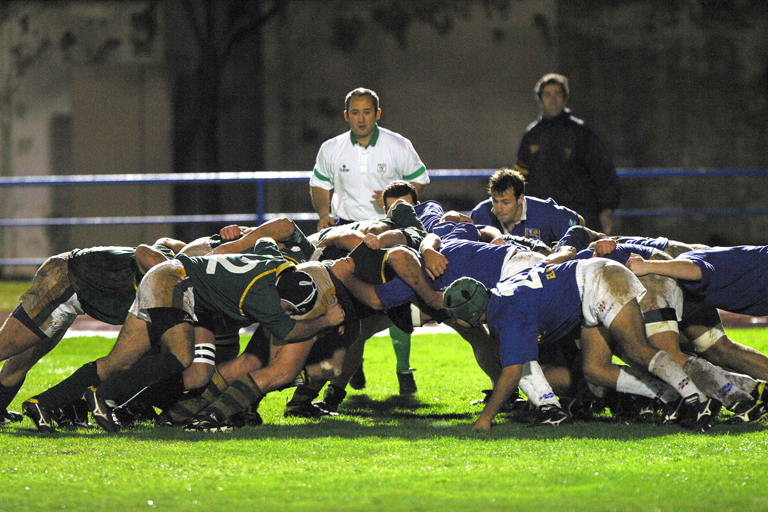How dangerous are concussions in rugby?
With the commencement of the new season there has been a raft of changes to the rules of rugby, which is now a familiar annual occurrence in rugby union. They have been introduced to both improve accuracy and flow of the game, and to attempt to speed up what can be a “slow, kick and chase” game.
One particular rule change has become the biggest move forward in the rule-book this year – the rule concerning concussion.
Previously when a player had suffered concussion or was suspected of such an injury a medic would be called onto the field to quickly assess whether the player was able to continue playing or not. This practise presents several problems and provides a poor clinical setting for medics to make a proper diagnosis.
The ruling now states that if a player is identified as having a potential concussive injury, that player should be substituted and removed from the field of play to be assessed off-field before a decision is made about the player’s ability to return to the game – for anyone familiar with the game this is akin to the” blood bin” system. This allows medical professionals enough time to make an accurate and safe assessment, which is ultimately safer for players.
But why all the precautions and should rugby players simply “man up”?
Rugby and other contact sports have an unsavoury history with head injuries. Michael Lipman, (former Bath and England Flanker), recently quit from the Melbourne Rebels due to recurring concussive injuries and Benson Stanley, (a promising Kiwi centre now playing for Clermont Auvergne), has contemplated retiring despite only being 28 years old because of repeated head injuries that have left him on the side-lines for long periods of time.
Steve Devine, a former All Black player, had the misfortune of playing without these new rules. His last season was marred by 2 heavy concussions, the latter of which lost him his two front teeth, broke his nose and caused concussive symptoms which remained with him for 2 and half years.
It is this loss of consciousness that the new rules are designed to detect. Even if a player is knocked out for a second they should not return to the field. This should be rigorously enforced at junior levels because of ‘Second Impact Syndrome’ (SIS). SIS occurs when, after a first concussion/head injury is suffered, the player continues to play and then quickly suffers a second concussion. It is thought that after the first concussion, the brain loses the ability to regulate the diameter of the arterioles, greatly increasing cerebral blood flow. The increase in blood and brain volume causes huge intracranial pressure and leads to brain herniation, which usually kills the sufferer. SIS can occur days or weeks after the first concussion and so players at professional level must not return to the field for 2 weeks after a concussion. Their training should also be closely monitored.
These seemingly short term effects can have a cumulative affect. Chronic traumatic encephalopathy (CTE) is a progressive degenerative disease, diagnosed in a post-mortem examination or brain biopsy. It is associated with those that have taken part in contact sports like rugby, American football and boxing at a high level. Its symptoms include dementia, depression and loss of muscular control. It can be caused by repeated concussions throughout a career but it can also be attributed to an accumulation of ‘sub-concussions’.
For example, consider an American football lineman, averaging 300lbs (136kg) wholines up for each game, crashing into an opposing lineman head-first wearing helmets. Each impact produces a force roughly equivalent to a head-on collision in a car at 30mph. NFL linemen will do this around 1500 times a year. This force isn’t strong enough to cause headaches or concussive symptoms, but it can stretch the axons of neurones inside the brain linearly and rotationally which can eventually cause brain damage.
Rugby players should take these findings with some scepticism. American football is a very different game to rugby, head clashes are rarer and the number of events where a sub-concussive event could occur is reduced. CTE is also a misunderstood condition. More research is needed to ascertain what actually occurs and with a study under way at the Boston University School of Medicine, USA, the pathology and consequences of the condition can be uncovered in the near future.
So what can be taken from all this information about concussion?
The Rugby Union has taken a great step forward in player safety. We all love to see great athletes competing at their peak and these measures should prolong the careers of those talents who would have otherwise been cut short.
More could still be done at amateur level to educate those involved about the dangers of concussion. All incidents should be taken seriously, perhaps moreso than any other injury on the pitch. RFU coaching courses could teach coaches of the future about the dangers and what to do for players’ safety. Local clubs could also provide more information about injury prevention in general for parents to protect their children.

Comments